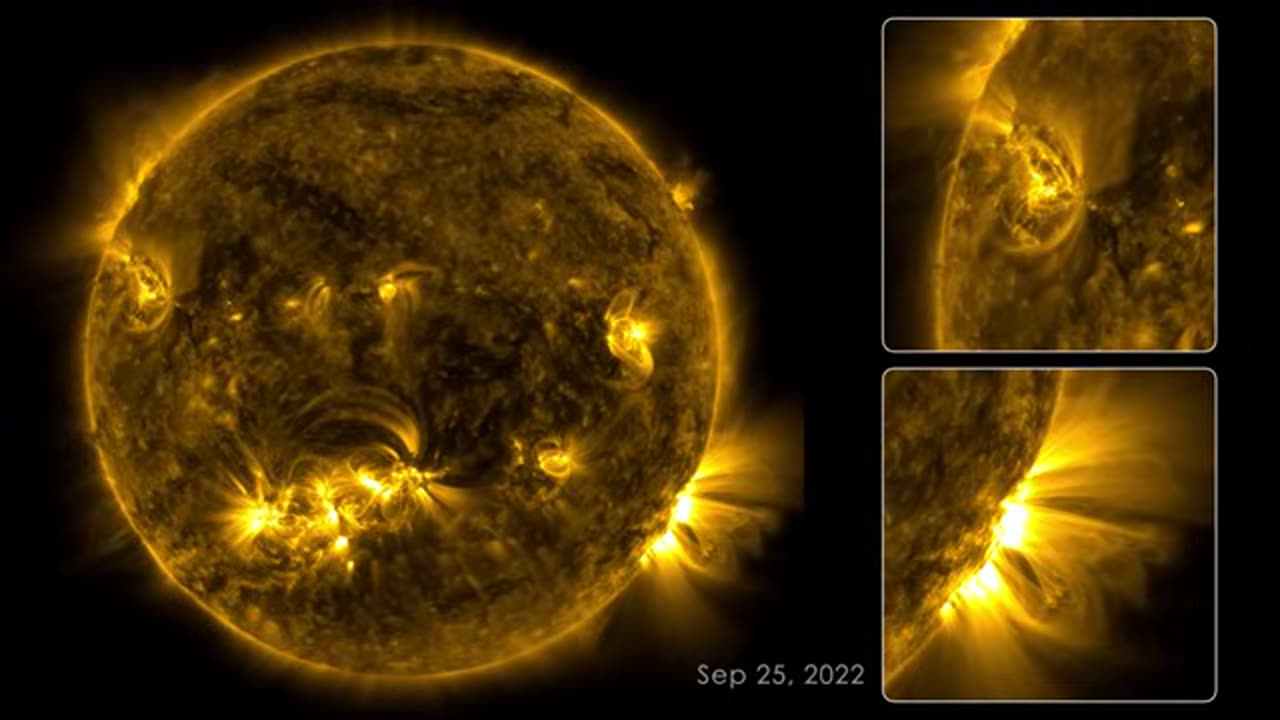Premium Only Content

133 Days on the Sun !!
133 Days on the Sun !!
chronicles solar activity from Aug. 12 to Dec. 22, 2022, as captured by NASA’s Solar Dynamics Observatory (SDO). From its orbit in space around Earth, SDO has steadily imaged the Sun in 4K x 4K resolution for nearly 13 years. This information has enabled countless new discoveries about the workings of our closest star and how it influences the solar system. With a triad of instruments, SDO captures an image of the Sun every 0.75 seconds. The Atmospheric Imaging Assembly (AIA) instrument alone captures images every 12 seconds at 10 different wavelengths of light. This 133-day time lapse showcases photos taken at a wavelength of 17.1 nanometers, which is an extreme-ultraviolet wavelength that shows the Sun’s outermost atmospheric layer: the corona. Compiling images taken 108 seconds apart, the movie condenses 133 days, or about four months, of solar observations into 59 minutes. The video shows bright active regions passing across the face of the Sun as it rotates. The Sun rotates approximately once every 27 days. The loops extending above the bright regions are magnetic fields that have trapped hot, glowing plasma. These bright regions are also the source of solar flares, which appear as bright flashes as magnetic fields snap together in a process called magnetic reconnection. While SDO has kept an unblinking eye pointed toward the Sun, there have been a few moments it missed. Some of the dark frames in the video are caused by Earth or the Moon eclipsing SDO as they pass between the spacecraft and the Sun. Other blackouts are caused by instrumentation being down or data errors. SDO transmits 1.4 terabytes of data to the ground every day.
On the left side of the frame is the full circle of the Sun. It appears in a golden yellow color, but splotchy and with thin yellow wisps extending from the surface. Some areas are very bright and others almost black. The whole Sun rotates steadily, with one full rotation taking 12 minutes in this time lapse. There are usually only a few bright regions visible at a time and they shift and flash like small fires. From these regions there are wispy loops reaching up above the surface that rapidly change shape and size. On the right side of the frame are two white-outlined squares with enlargements of interesting regions of the Sun.
NASA’s Goddard Space Flight Center · Instagram http://www.instagram.com/nasagoddard · Twitter http://twitter.com/NASAGoddard · Twitter http://twitter.com/NASAGoddardPix · Facebook: http://www.facebook.com/NASAGoddard · Flickr http://www.flickr.com/photos/gsfc
-
 LIVE
LIVE
Kim Iversen
34 minutes agoAre The "Fat Generals" Just A Cover For War With Iran?
922 watching -
 LIVE
LIVE
Candace Show Podcast
1 hour agoDEAD OR ALIVE: Who Betrayed Charlie Kirk? | Ep 245
7,275 watching -
 1:40:32
1:40:32
Redacted News
1 hour ago"This was 100% a CIA hit!" Charlie Kirk's Assassination Story COLLAPSES Amid New Evidence | Redacted
88.1K76 -
 39:40
39:40
The White House
3 hours agoPresident Trump Signs Executive Orders, Sep. 30, 2025
19.1K21 -
 1:06:26
1:06:26
vivafrei
3 hours agoLive with Alexa Lavoie! ANTIFA in Canadian Government? RCMP the New Gestapo? AND MORE!
128K34 -
 LIVE
LIVE
Dad Saves America
23 hours agoLeft Is Right, Up Is Down: The Overton Window Has Been Shattered
135 watching -
 LIVE
LIVE
LFA TV
18 hours agoBREAKING NEWS ALL DAY! | TUESDAY 9/30/25
1,124 watching -
 LIVE
LIVE
freecastle
5 hours agoTAKE UP YOUR CROSS- May the forces of evil become confused on the way to your house.
192 watching -
 1:23:05
1:23:05
Awaken With JP
5 hours agoGetting NUTS! FBI Did J6, Comey Indicted, and More! - LIES ep 110
41.6K25 -
 2:09:51
2:09:51
Pop Culture Crisis
2 hours agoJK Rowling OBLITERATES Emma Watson, Trump Vs Ariana Grande, Could The Rock be President? | Ep. 926
21.1K7